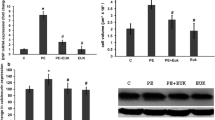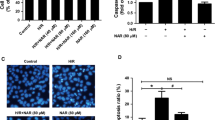Abstract
Enhanced sympathetic system activation mediated by norepinephrine (NE) contributes to adverse cardiac remodeling leading to oxidative stress and cell death, progressing to heart failure. Natural antioxidants may help maintain redox balance, attenuating NE-mediated cardiac cell damage. In the present study, we evaluated the effect of a blueberry extract (BBE) on H9c2 cardiac cells exposed to NE on cell death, oxidative stress status and its major signaling pathways. H9c2 cells were pre-incubated with 50 μg/ml of BBE for 4 h and maintained in the presence of 100 μM NE for 24 h. NE exposure resulted in increased caspase 3/7 activity. This was associated with reduced protein expression of antioxidants catalase, superoxide dismutase and glutathione peroxidase and increase in 4-hydroxynonenal adduct formation. NE led to increased activity of Protein kinase B (Akt), Forkhead box O3a and AMP-activated protein kinase alpha and decreased activity of Signal transducer and activator of transcription 3. BBE prevented caspases activation and abrogated NE-induced increase in oxidative stress, as well as attenuated the increase in Akt. Based on these findings, it is concluded that BBE promoted cardioprotection of H9c2 cells in an in vitro model of NE-induced oxidative damage, suggesting a cardioprotective role for BBE in response to NE exposure.







Similar content being viewed by others
Data availability
Available upon request.
References
Antoine S, Vaidya G, Imam H, Villarreal D (2017) Pathophysiologic mechanisms in heart failure: role of the sympathetic nervous system. Am J Med Sci 353:27–30
Corbi G, Conti V, Russomanno G, Longobardi G, Furgi G, Filippelli A et al (2013) Adrenergic signaling and oxidative stress: a role for sirtuins? Front Physiol 4:324
Bovo E, Lipsius SL, Zima AV (2012) Reactive oxygen species contribute to the development of arrhythmogenic Ca2+ waves during β-adrenergic receptor stimulation in rabbit cardiomyocytes. J Physiol 590:3291–3304
Remondino A, Kwon SH, Communal C, Pimentel DR, Sawyer DB, Singh K et al (2003) Beta-adrenergic receptor-stimulated apoptosis in cardiac myocytes is mediated by reactive oxygen species/c-Jun NH2-terminal kinase-dependent activation of the mitochondrial pathway. Circ Res 92:136–138
Schieber M, Chandel NS (2014) ROS function in redox signaling and oxidative stress. Curr Biol 24(10):R453–R462
von Harsdorf R, Li PF, Dietz R (1999) Signaling pathways in reactive oxygen species-induced cardiomyocyte apoptosis. Circulation 99:2934–2941
Prior RL, Cao G, Prior RL, Cao G (2000) Analysis of botanicals and dietary supplements for antioxidant capacity: a review. J AOAC Int 83:950–956
Elks CM, Reed SD, Mariappan N, Shukitt-Hale B, Joseph JA, Ingram DK et al (2011) A blueberry-enriched diet attenuates nephropathy in a rat model of hypertension via reduction in oxidative stress. PLOS One 6:e24028
Riso P, Klimis-Zacas D, Del Bo’ C, Martini D, Campolo J, Vendrame S et al (2013) Effect of a wild blueberry (Vaccinium angustifolium) drink intervention on markers of oxidative stress, inflammation and endothelial function in humans with cardiovascular risk factors. Eur J Nutr 52:949–961
Basu A, Rhone M, Lyons TJ (2010) Berries: emerging impact on cardiovascular health. Nutr Rev 68:168–177
Liu Y, Tan D, Shi L, Liu X, Zhang Y, Tong C et al (2015) Blueberry anthocyanins-enriched extracts attenuate cyclophosphamide-induced cardiac injury. PLoS One 10:e0127813
Ahmet I, Spangler E, Shukitt-Hale B, Joseph JA, Ingram DK, Talan M (2009) Survival and cardioprotective benefits of long-term blueberry enriched diet in dilated cardiomyopathy following myocardial infarction in rats. PLOS One 4:e7975
Türck P, Fraga S, Salvador I, Campos-Carraro C, Lacerda D, Bahr A et al (2020) Blueberry extract decreases oxidative stress and improves functional parameters in lungs from rats with pulmonary arterial hypertension. Nutrition 70:110579. https://doi.org/10.1016/j.nut.2019.110579
Darzynkiewicz Z, Pozarowski P, Lee BW, Johnson GL (2011) Fluorochrome-labeled inhibitors of caspases: convenient in vitro and in vivo markers of apoptotic cells for cytometric analysis. Methods Mol Biol 682:103–114
Sengupta A, Molkentin JD, Paik JH, DePinho RA, Yutzey KE (2011) FoxO transcription factors promote cardiomyocyte survival upon induction of oxidative stress. J Biol Chem 286:7468–7478
Oellerich MF, Potente M (2012) FOXOs and sirtuins in vascular growth, maintenance, and aging. Circ Res 110:1238–1251
Barry SP, Townsend PA, McCormick J, Knight RA, Scarabelli TM, Latchman DS et al (2009) STAT3 deletion sensitizes cells to oxidative stress. Biochem Biophys Res Commun 385:324–329
Ishii I, Harada Y, Kasahara T (2012) Reprofiling a classical anthelmintic, Pyrvinium pamoate, as an anti-cancer drug targeting mitochondrial respiration. Front Oncol 2:137
Zhu YP, Brown JR, Sag D, Zhang L, Suttles J (2015) Adenosine 5’-monophosphate-activated protein kinase regulates IL-10-mediated anti-inflammatory signaling pathways in macrophages. J Immunol 194:584–594
Sid B, Verrax J, Calderon PB (2013) Role of AMPK activation in oxidative cell damage: Implications for alcohol-induced liver disease. Biochem Pharmacol 86:200–209
Zhao D, Yang J, Yang L (2017) Insights for oxidative stress and mTOR signaling in myocardial ischemia/reperfusion injury under diabetes. Oxid Med Cell Longev 2017:6437467
Gutiérrez-Uzquiza Á, Arechederra M, Bragado P, Aguirre-Ghiso JA, Porras A (2012) p38α mediates cell survival in response to oxidative stress via induction of antioxidant genes: effect on the p70S6K pathway. J Biol Chem 287:2632–2642
Brum PC, Rolim NP, Bacurau AV, Medeiros A (2006) Neurohumoral activation in heart failure: the role of adrenergic receptors. An Acad Bras Cienc 78:485–503
Louis XL, Thandapilly SJ, Kalt W, Vinqvist-Tymchuk M, Aloud BM, Raj P et al (2014) Blueberry polyphenols prevent cardiomyocyte death by preventing calpain activation and oxidative stress. Food Funct 5:1785–1794
Del Bo’ C, Roursgaard M, Porrini M, Loft S, Møller P, Riso P (2016) Different effects of anthocyanins and phenolic acids from wild blueberry (Vaccinium angustifolium) on monocytes adhesion to endothelial cells in a TNF-α stimulated proinflammatory environment. Mol Nutr Food Res 60:2355–2366
Fu YC, Chi CS, Yin SC, Hwang B, Chiu YT, Hsu SL (2004) Norepinephrine induces apoptosis in neonatal rat cardiomyocytes through a reactive oxygen species-TNF alpha-caspase signaling pathway. Cardiovasc Res 62:558–567
Mao W, Fukuoka S, Iwai C, Liu J, Sharma VK, Sheu SS et al (2007) Cardiomyocyte apoptosis in autoimmune cardiomyopathy: mediated via endoplasmic reticulum stress and exaggerated by norepinephrine. Am J Physiol Heart Circ Physiol 293:H1636–H1645
Meeran MF, Jagadeesh GS, Selvaraj P (2016) Synthetic catecholamine triggers β1-adrenergic receptor activation and stimulates cardiotoxicity via oxidative stress mediated apoptotic cell death in rats: abrogating action of thymol. Chem Biol Interact 251:17–25
Neri M, Cerretani D, Fiaschi AI, Laghi PF, Lazzerini PE, Maffione AB et al (2007) Correlation between cardiac oxidative stress and myocardial pathology due to acute and chronic norepinephrine administration in rats. J Cell Mol Med 11:156–170
Thakur A, Alam MJ, Ajayakumar MR, Ghaskadbi S, Sharma M, Goswami SK (2015) Norepinephrine-induced apoptotic and hypertrophic responses in H9c2 cardiac myoblasts are characterized by different repertoire of reactive oxygen species generation. Redox Biol 5:243–252
Folden DV, Gupta A, Sharma AC, Li SY, Saari JT, Ren J (2003) Malondialdehyde inhibits cardiac contractile function in ventricular myocytes via a p38 mitogen-activated protein kinase-dependent mechanism. Br J Pharmacol 139:1310–1316
Mali VR, Palaniyandi SS (2014) Regulation and therapeutic strategies of 4-hydroxy-2-nenal metabolism in heart disease. Free Radic Res 48:251–263
Hare JM (2001) Oxidative stress and apoptosis in heart failure progression. Circ Res 89:198–200
Kumar D, Lou H, Singal PK (2002) Oxidative stress and apoptosis in heart dysfunction. Herz 27:662–668
Çoban J, Doğan-Ekici I, Aydın AF, Betül-Kalaz E, Doğru-Abbasoğlu S, Uysal M (2015) Blueberry treatment decreased D-galactose-induced oxidative stress and brain damage in rats. Metab Brain Dis 30:793–802
Huang WY, Wu H, Li DJ, Song JF, Xiao YD, Liu CQ et al (2018) Protective effects of blueberry anthocyanins against H2O2-induced oxidative injuries in human retinal pigment epithelial cells. J Agric Food Chem 66:1638–1648
Chiribau CB, Cheng L, Cucoranu IC, Yu YS, Clempus RE, Sorescu D (2008) FOXO3A regulates peroxiredoxin III expression in human cardiac fibroblasts. J Biol Chem 283:8211–8217
Morris BJ, Willcox DC, Donlon TA, Willcox BJ (2015) FOXO3: a major gene for human longevity–a mini-review. Gerontology 61:515–525
Klotz LO, Sánchez-Ramos C, Prieto-Arroyo I, Urbánek P, Steinbrenner H, Monsalve M (2015) Redox regulation of FoxO transcription factors. Redox Biol 6:51–72
Oh HM, Yu CR, Dambuza I, Marrero B, Egwuagu CE (2012) STAT3 protein interacts with class O Forkhead transcription factors in the cytoplasm and regulates nuclear/cytoplasmic localization of FoxO1 and FoxO3a proteins in CD4(+) T cells. J Biol Chem 287:30436–30443
Brault L, Gasser C, Bracher F, Huber K, Knapp S, Schwaller J (2010) PIM serine/threonine kinases in the pathogenesis and therapy of hematologic malignancies and solid cancers. Haematologica 95:1004–1015
Shi Y, Zhang Z, Qu X, Zhu X, Zhao L, Wei R et al (2018) Roles of STAT3 in leukemia (review). Int J Oncol 53:7–20
Haga S, Terui K, Zhang HQ, Enosawa S, Ogawa W, Inoue H et al (2003) Stat3 protects against Fas-induced liver injury by redox-dependent and -independent mechanisms. J Clin Invest 112:989–998
Poli V, Camporeale A (2015) STAT3-mediated metabolic reprograming in cellular transformation and implications for drug resistance. Front Oncol 5:121
Dorn GW 2nd, Force T (2005) Protein kinase cascades in the regulation of cardiac hypertrophy. J Clin Invest 115:527–537
McMullen JR, Sherwood MC, Tarnavski O, Zhang L, Dorfman AL, Shioi T et al (2004) Inhibition of mTOR signaling with rapamycin regresses established cardiac hypertrophy induced by pressure overload. Circulation 109:3050–3055
Shen WH, Chen Z, Shi S, Chen H, Zhu W, Penner A et al (2008) Cardiac restricted overexpression of kinase-dead mammalian target of rapamycin (mTOR) mutant impairs the mTOR-mediated signaling and cardiac function. J Biol Chem 283:13842–13849
Zhang D, Contu R, Latronico MV, Zhang J, Rizzi R, Catalucci D et al (2010) MTORC1 regulates cardiac function and myocyte survival through 4E-BP1 inhibition in mice. J Clin Invest 120:2805–2816
Chen L, Xu B, Liu L, Luo Y, Yin J, Zhou H et al (2010) Hydrogen peroxide inhibits mTOR signaling by activation of AMPK alpha leading to apoptosis of neuronal cells. Lab Invest 90:762–773
Williams CM, El Mohsen MA, Vauzour D, Rendeiro C, Butler LT, Ellis JA et al (2008) Blueberry-induced changes in spatial working memory correlate with changes in hippocampal CREB phosphorylation and brain-derived neurotrophic factor (BDNF) levels. Free Radic Biol Med 45:295–305
Cao C, Lu S, Kivlin R, Wallin B, Card E, Bagdasarian A et al (2008) AMP-activated protein kinase contributes to UV- and H2O2-induced apoptosis in human skin keratinocytes. J Biol Chem 283:28897–28908
Funding
This work was funded by the Brazilian National Council for Scientific Development (CNPq) and the Northern Ontario School of Medicine (NOSM) Faculty Association Research Development Funds.
Author information
Authors and Affiliations
Contributions
Data collection, analysis and writing the first draft: PT. Design of the study and supervised the research: NK, AB-K, SRA. Flow cytometry data acquisition and analysis: PT, AN-B, TT. Critical revision of the manuscript: PT, NK, AB-K, SRA, ZS. Primary investigator: NK.
Corresponding author
Ethics declarations
Conflict of interest
The authors declare no conflict of interest.
Ethical approval
Not applicable.
Consent to participate
Not applicable.
Consent for publication
Not applicable.
Additional information
Publisher's Note
Springer Nature remains neutral with regard to jurisdictional claims in published maps and institutional affiliations.
Rights and permissions
About this article
Cite this article
Türck, P., Nemec-Bakk, A., Talwar, T. et al. Blueberry extract attenuates norepinephrine-induced oxidative stress and apoptosis in H9c2 cardiac cells. Mol Cell Biochem 477, 663–672 (2022). https://doi.org/10.1007/s11010-021-04313-z
Received:
Accepted:
Published:
Issue Date:
DOI: https://doi.org/10.1007/s11010-021-04313-z




